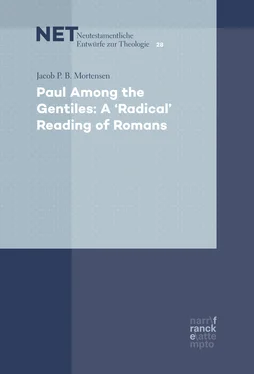The greetings in Rom 16 work much better in a Roman than in an Ephesian context. Although Paul reveals personal knowledge of only nine of the people on his list, the rest may have been well-known individuals in the Roman congregation.10 It should not be considered odd that Paul knew of twenty-six people in Rome, when his close companions (Prisca and Aquila) were in Rome, and could have informed him of the people living there – especially in view of his plans to visit Rome. Prisca and Aquila may have travelled back and forth between Rome and the Aegean region several times, because of the Edict of Claudius11 and business in Ephesus. And the names in Rom 16 are otherwise attested in Rome through ancient inscriptions.12 Identifying Epaenetus as the first convert in Asia (16:5) also makes little sense if chapter 16 was originally addressed to Ephesus, because the Asian Ephesians would already know Epaenetus. On the other hand, the Romans may have been unfamiliar with Epaenetus’s significance. Besides, would it not make more sense that the Ephesians already knew Prisca and Aquila, Paul’s co-workers, since they would have known that Timothy was his co-worker (16:21)? And does not the number of people greeted in Romans actually argue against an Ephesian destination, since in no other letter does Paul attach such an extensive list of greetings to a church with which he was familiar? In Ephesus, Paul would surely have known more than twenty-six persons, and he might have risked offending Ephesians who were not specifically mentioned. And if he had continued the practice begun in the other letters, he would have referred to his experiences and future plans with the Ephesians. Consequently, a Roman destination makes more sense. By listing all these names and greetings at the end of the letter, Paul was establishing his authority and commending his ministry by means of his associations with respected persons in Rome who could serve as character references.13 In greeting and highlighting his contacts in Rome, he was laying the foundation for his future work and new ministry in the West in Spain.14
The concluding elements of Rom 16 are typical of a Pauline letter closing: greetings (16:3–15), kiss of peace (16:16), admonition (16:17–20), and grace benediction (16:20).15 If Rom 16 were intended for Ephesus, 15:33 would be the conclusion of the letter, with its wish for peace. But Paul does not conclude any of his other letters with a wish for peace. Elsewhere in Paul, such wishes for peace precede the greetings, as in Rom 16 (cf. Phil 4:9; 2 Cor 13:11; 1 Thess 5:23; Gal 6:16 (also, cf. 2 Thess 3:16; Eph 6:23)). Besides, the grace benediction in 16:20b, 24 is exactly what we would expect in a Pauline ending. Thus, Karl P. Donfried’s words concerning the place of Rom 16 in Paul’s original letter to the Romans is worth repeating: ‘An especially significant shift has occurred with regard to the understanding of Romans 16, which is now viewed by the majority [of scholars] as being an integral part of Paul’s original letter’.16 Any reconstruction of the situation in the Roman congregation must employ the full sixteen chapters.17 Therefore, I take chapter 16 to be an original part of Romans.18
Paul probably wrote this letter from Cenchreae (the port of Corinth), since he commends Phoebe, a deacon of that city (16:1–2), to the recipients of Romans. He also sends greetings from Gaius, who is the host of the church from which Paul writes, and we know from Rom 16:23 and 1 Cor 1:14 that there was a prominent Gaius at Corinth. In chapter 15, Paul reveals his plan to bring a collection to Jerusalem (15:26–33). Thus, scholars widely agree that Paul spend the winter of 57/58 (or 55/56) in Corinth, and afterwards returned through Macedonia, Asia, and Caesarea to Jerusalem, where he was arrested.
If Romans is a real letter, given the diatribal or other literary and rhetorical features, there must be a real audience. This audience is crucial for determining the purpose (and argument) of Romans, so we must ask, what we can know about this audience?
Addressees, audience, recipients: external versus internal evidence
The majority of scholars contend that Romans was intended for both Jews and Gentiles, albeit primarily for Jews.1 This is based on external and internal evidence from the letter. The external factors concern the possible (but speculative and hypothetical) ethnic composition of Roman believers in Christ at the time of Paul. However, we have no evidence with which to reconstruct the Christ-believing community/communities in Rome prior to Paul’s letter.2 Romans provides the earliest evidence of any Christ-believing people in Rome. Regardless of how many – if any – Jews or Christ-believing Gentiles Claudius expelled from Rome in 49 AD, that event can have no bearing on our understanding of the audience of the letter. On the other hand, the internal factors relate to Paul’s explicit mention of the identity of the interlocutor in Rom 2–4, the strong and the weak (14–15), the greetings at the end of the letter, and various other aspects of the letter (1–11). The majority of scholars take these factors to imply an at least partly Jewish audience.
Stanley Stowers and Runar Thorsteinsson suggest speaking of the encoded audience/reader, rather than the real, historical, or actual audience, to avoid speculation concerning the ethnic composition of the actual (historical) Roman congregation.3 The encoded reader/audience is the manifest audience in the text, and it constitutes a strategy within the text; this is the reader the author himself constructs, for example, when Paul writes to ‘all the Gentiles, including yourselves‘ (1:5) or when he writes ‘I am speaking to you Gentiles’ (11:13).4 Thus, the encoded reader/audience is the reader explicitly inscribed in the text, and a feature of the text itself. According to Stowers and Thorsteinsson, the encoded/intended reader was not necessarily identical to the actual readers of the letter when it arrived in Rome. We can never know who the actual or empirical readers were; they remain in the sphere of a historical reconstruction that may easily become speculation.5 And even though from a historical point of view we may be certain that there were Jews in Rome,6 it simply does not follow that the letter was addressed to them.
To reveal the purpose of Paul’s letter, it is crucial to determine the identity of the encoded/implied reader or audience. Hence, the starting point for an analysis of the audience of Romans follows from the text-internal evidence, which reveals the encoded or intended audience. The audience of Romans may be confirmed only by the letter itself. However, and here we may be moving beyond what Stowers and Thorsteinsson (and others) have suggested: if the literary function of the letter’s encoded reader/audience turns out to have a bearing on the purpose of the letter (primarily the paraenetic part of the letter), these two – in combination – may also constitute a weighty argument concerning the (actual, historical) addressees of the letter.7 Consequently, if we can argue for the unity and continuity of the letter from chapter 1 to chapter 16, the unity, continuity, and sequence of the letter may establish a firmer point from which to draw conclusions about the actual and historical addressees in the Roman congregation.
The recipients/audience of Paul’s letter are identifiable by certain explicit internal factors. These appear in 1:5–7; 1:13–15; 11:13; and 15:15–16. According to ancient epistolary practices, the recipient of a letter is addressed in the dative case. In 1:7 Paul addresses ‘all God’s beloved in Rome, who are called to be saints’ (πᾶσιν τοῖς οὖσιν ἐν Ῥώμῃ ἀγαπητοῖς θεοῦ, κλητοῖς ἁγίοις), in the dative case. Thus, Paul identifies the religious and social affiliation of the addressees, but not their ethnicity. However, he does that in the preceding verses (1:5–6). The readers (who are God’s beloved and saints) already know that they should count themselves among ‘all the Gentiles’ (ἐν πᾶσιν τοῖς ἔθνεσιν), because Paul writes ἐν οἷς ἐστε καὶ ὑμεῖς (among whom also you are). All God’s beloved in Rome, including themselves, are among the Gentiles (to whom Paul was appointed apostle). Thus, right from the outset, Paul is explicit about the ethnic identity of the encoded audience and addressees.
Читать дальше












